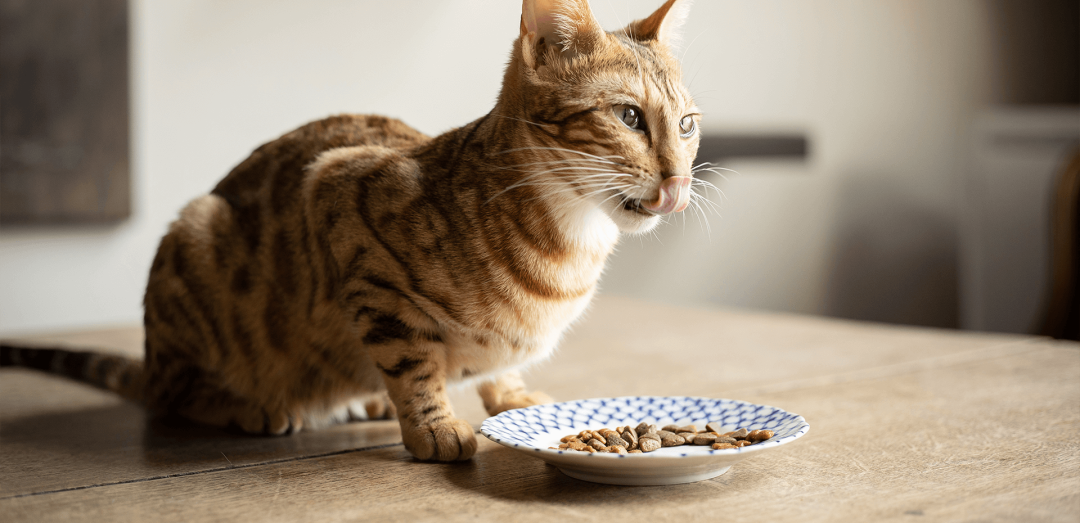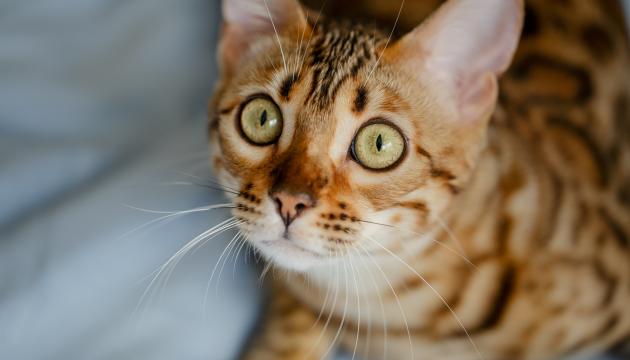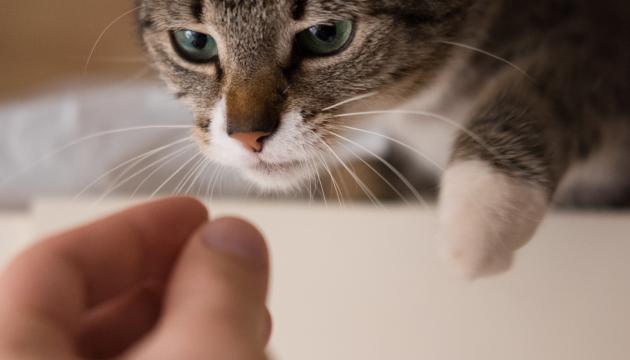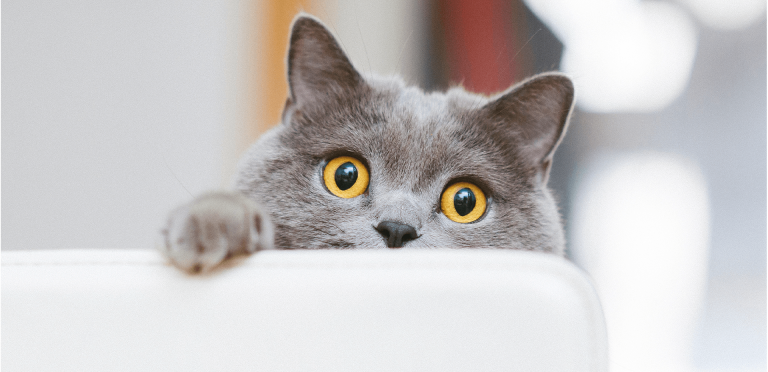

Training a cat: Tips for success and easy everyday skills
Training a cat may seem like an impossible task, but patience and cat-centred training methods will help you succeed. Especially with a kitten, it is good to focus on the most essential skills like training the cat to accept nail trimming and getting it used to a carrier.
Training a cat is often easiest when the cat is still a kitten, since it is easier to motivate an active young cat than an adult one. Read this article to find out how to get started with training a cat and what everyday skills your kitten should learn. At the end of the article, you will find practical tips on teaching your cat everyday skills.
Is training a cat difficult?
Training a cat is usually more difficult than dog training, due to the cat’s behaviour and natural needs of cats. When training a cat, it is essential to keep in mind what kind of animal a cat is.
Predatory carnivore: Despite living near humans for thousands of years, cats are not fully domesticated pets. Scientists have estimated that it could take up to hundreds of years for cats to become fully domesticated. Therefore, a cat's actions and behaviour are strongly influenced by the nature, needs and, above all, instincts of the predator.
Independent roamer: The domestic cat, Felis Catus, does not belong in the wild, but it has a better chance of surviving in nature than a dog that relies heavily on human care. Cats can take care of themselves to a certain extent, making motivating them with treats and play with humans not as easy as with dogs. Training a cat is often difficult because food rewards and toys may not interest the cat at all.
Cat logic: The habits a cat has learned are persistent and often difficult to change. Cats aim to do things in the most beneficial and logical way for themselves. A cat’s logic is based on instincts, mainly predatory behaviour, and sex drive.
However, every animal can be trained to some extent if you know how to utilize the animal's natural behaviour and learn the most suitable training techniques.
Would you like to know more about a cat's hunting behaviour? Read our article on a cat's natural diet.

Basics of cat training
1. Basic idea is the same as in dog training
The basic idea behind training a cat is very similar thana in dog training. The desired behaviour is made beneficial to the cat, meaning the cat is rewarded with food or play for the correct actions.
When training a cat you can use the same tools as with dogs, like a clicker and a target stick. The clicker helps to improve the timeliness of the reward, while the target stick helps leading the cat in the right direction.
2. Choose the right reward
For successful cat training, you need to find a reward that is motivating enough for your cat. In most cases, treats are the easiest reward to use, and for some cats, treats alone can be enough motivation. You can also use cat kibble as a reward to avoid overfeeding with treats.
Combining treats with play can work well for some cats, when using a treat that can be played with. For example, take advantage of the chase and capture phase of the cat's predatory chain by dropping or tossing the treat a short distance away from the cat. This way, the cat becomes interested in the movement and may start playing with the treat before eventually eating it. Similarly, tying a treat to a string can spark the cat's interest as the moving treat resembles captured prey.
The playfulness of the cat has appealed to humans, so cats with a stronger predatory instinct may have been selected for breeding. This is why certain cat breeds, like Ragdolls, are often more excited by predatory play than domestic shorthairs.
3. Pick the behaviour
So-called "picking the behaviour" can be a more effective training method than starting from scratch when teaching specific things. So let the cat hint what it wants to learn and let the cat train you to train itself. Take advantage of the gestures the cat gives you and reward the behaviour or habit you want to reinforce.
Associate a hand signal or similar gesture with the desired behaviour. Cats often understand body language more easily than verbal cues. Read more about cat’s body language.
Picking the behaviour also works well for teaching tricks. You can teach a cat to sit, spin around, or touch an object with its paw. When training a cat, divide the trick into small parts. For example, if you want your cat to learn to touch an object with its paw, it must first learn to lift the paw and so on.
4. Remember the direction and mindset of the reward
The direction of the reward matters. If you are teaching the cat to go around furniture, the reward must come from the same direction as the cat’s movement. Reward the cat from above if you want it to wait in a sitting position. The movement away should not be too fast; instead, reward the cat calmly in place.
Use a reward intensity similar to the desired action to reinforce the desired mindset. For instance, reward a calm behaviour calmly, and reward an active behaviour with energy, like throwing a treat quickly and using an excited tone. However, avoid overdoing the intensity of rewards and praises, as you don't want to startle the cat. Learn to recognise how your cat reacts to different types and styles of reward. This will help you to find the most suitable ways to motivate and reward your own cat.
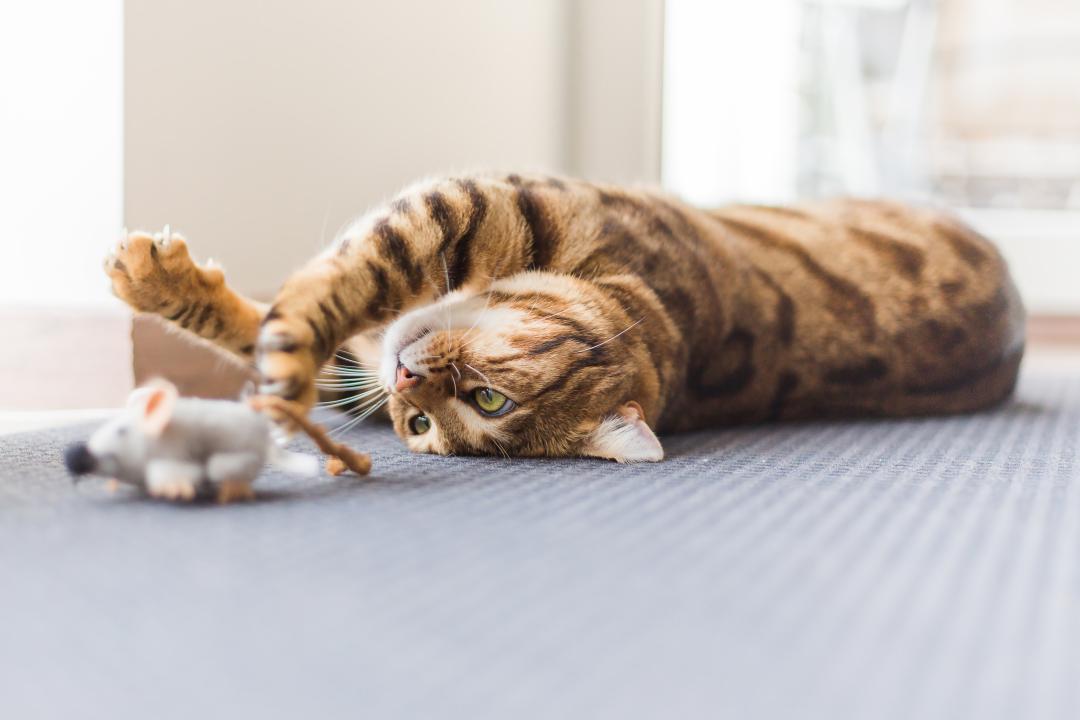
5. The cat trains you too
Often, the cat trains the human, not the other way around. For example, the cat may teach you to play with it by scratching the sofa or playing with the edge of a carpet. You can redirect such behaviour to a suitable toy instead of the furniture. For instance, the cat can show its willingness to play by touching a toy hanging in a string from the ceiling.
Many cats have taught their owners to give food by meowing in a particular way or displaying other behaviour. If a food-begging cat is too loud, you can teach the cat to sit in a specific spot when it wants food. Skills like this will help the cat to tell its owner more about its own needs, such as hunger.
Training a cat: Tips for teaching everyday skills
Training a cat is not mandatory, but besides getting your cat active, teaching certain everyday skills can make life with your cat easier and the training sessions enjoyable bonding moments. Additionally, getting your cat used to handling and the carrier can reduce stress during visits to the veterinarian.
How to teach a cat to use the litter box?
Cats are naturally tidy animals. For kittens raised by a breeder, the litter box is usually already familiar, as the mother teaches them the basics of using it. This is why kittens at the weaning age are often more house-trained than puppies of the same age.
The kitten's litter box should be low-sided and as wide as possible. For example, the bottom plastic of a large dog crate or a low-sided cardboard box lined with plastic can work well as a litter box. Make sure to spread a good layer of litter to prevent the cat's paws from getting wet.
Place the litter box in a spot where the cat's digging won't be a problem. Gradually increase the height of the litter box's sides and add an entrance when the cat has learned to use it.
To make litter box usage easier for your cat, consider having two litter boxes per cat, placed in easily accessible locations.
PrimaCat offers highly absorbent, fast-clumping and dust-free cat litters that are soft for your cat’s paws and make cat litter maintenance easier. Learn more about the products.

How to introduce a kitten to different foods?
Especially for kittens, new flavours can be exciting adventures, but for some cats, they can also be frightening. It is easy for a cat to get used to the same flavours, as familiar foods are safe to eat.
Kittenhood is a crucial time for introducing wide range of flavours to the cat. When the kitten gets used to different kinds of flavours and foods, it is easier to add new foods to the cat’s diet later in life. Some cats also like to have a different food every day. Others just want the same thing day after day. Read our guide on how to get your cat used to a new food.
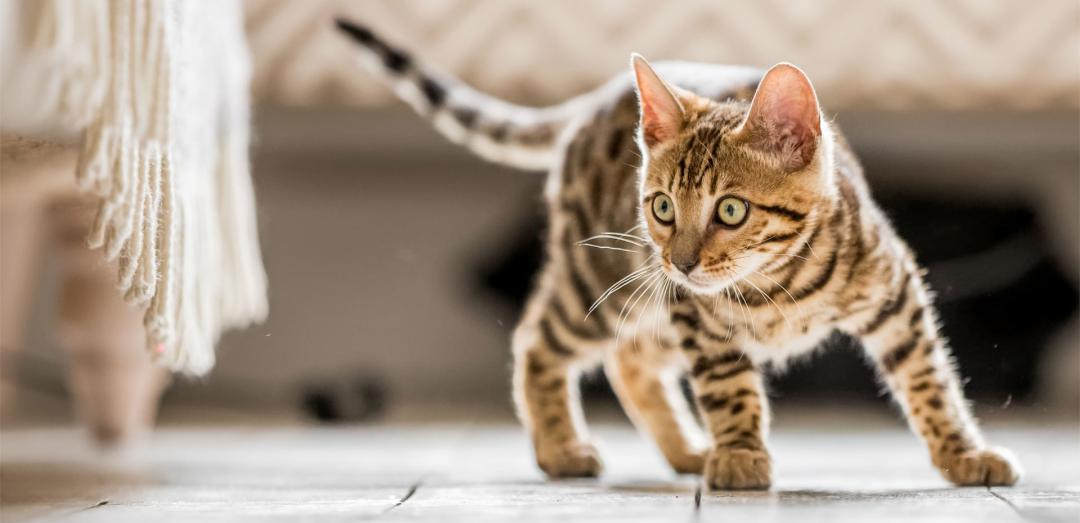
When feeding your kitten, don't be shy about using new flavours. You can also feed your kitten adult cat food, as long as the food designed for kittens covers the majority of the kitten's diet. You can also give your kitten additional foods such as white fish, chicken, and other meats to help it get used to different tastes.
PrimaCat range includes two cat foods designed for kittens: wheat-free dry food and grain-free wet food. All PrimaCat's cat foods contain plenty of meat and no added sugar. Read our tips on feeding a kitten.
How to train a kitten for nail trimming and other handling?
Training a cat for handling should begin when the cat is still a kitten. Often, allowing the cat to have a sense of autonomy during these interactions can facilitate the process, meaning that the cat gets to choose when it is comfortable with being handled.
Start practicing nail trimming while the kitten is tired. When the kitten is calmly on your lap, touch its paws and nails. Once the kitten is accustomed to this, introduce nail clippers. Let the cat sniff the clippers and gradually touch the nails with the clippers. At the same time, remember to reward and praise the cat. Once the cat is familiar with the clippers, you can start trimming the nails little by little.
When the cat is older and the situation is familiar and safe, the cat can start to choose when to have its nails clipped. Show the cat the clippers, and if the cat touches them, the nails can be clipped. Give the cat a treat when it touches the clippers, and make sure the nail trimming position is comfortable for the cat.
Begin by trimming the nails on one paw and ask the cat if is it okay to continue. This way, both you and the cat can have a comfortable experience, and it doesn't have to be forced. Also, remember that the cat should always have access to a good scratching post.
Looking for tempting treats for your cat’s training sessions? All PrimaCat's cat treats are not only delicious but also sugar-free. Explore PrimaCat treat selection.

How to train a cat to travel in a carrier?
Make the carrier a familiar and pleasant part of the cat's daily life. The carrier can be accessible to the cat as a resting place or as a hideaway during playtime. However, it is not suitable for feeding, as cats prefer to eat in an open space.
Practice lifting and carrying the carrier indoors first, taking the cat to different rooms and then returning. The cat will feel safer when it knows that the carrier always returns to its starting point.
Initially, take the cat on short trips in the carrier, making the travel experience as enjoyable as possible. You can also cover the carrier with a towel if it helps the cat feel more at ease.
Can a cat be trained to calm down at night?
Cats are naturally nocturnal animals, meaning they are more active during the night and tend to rest during the day. Some cats quickly adapt to a human's daily rhythm, while others stick to their own schedule.
Training might not completely remove a cat's nighttime activities, but you can try to control them by activating the cat during the day. Some cat enthusiasts have even created a playroom for their cats to release energy at a specific time of the day.
A cat's feeding routine involves several small meals throughout the day and night, so their nighttime meowing and activities might also be due to hunger. In this case, consider offering a small late-night snack or try a timed automatic cat feeder for the night.
